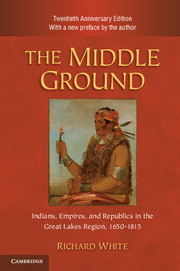Book contents
- Frontmatter
- Contents
- List of abbreviations
- Preface to the twentieth anniversary edition
- Introduction
- 1 Refugees: a world made of fragments
- 2 The middle ground
- 3 The fur trade
- 4 The alliance
- 5 Republicans and rebels
- 6 The clash of empires
- 7 Pontiac and the restoration of the middle ground
- 8 The British alliance
- 9 The contest of villagers
- 10 Confederacies
- 11 The politics of benevolence
- Epilogue: Assimilation and otherness
- Index
1 - Refugees: a world made of fragments
Published online by Cambridge University Press: 05 June 2012
- Frontmatter
- Contents
- List of abbreviations
- Preface to the twentieth anniversary edition
- Introduction
- 1 Refugees: a world made of fragments
- 2 The middle ground
- 3 The fur trade
- 4 The alliance
- 5 Republicans and rebels
- 6 The clash of empires
- 7 Pontiac and the restoration of the middle ground
- 8 The British alliance
- 9 The contest of villagers
- 10 Confederacies
- 11 The politics of benevolence
- Epilogue: Assimilation and otherness
- Index
Summary
Human populations construct their cultures in interaction with one another, and not in isolation.
Eric Wolf,Europe and the People Without HistoryThe Frenchmen who traveled into the pays d'en haut, as they called the lands beyond Huronia, thought they were discovering new worlds. They were, however, doing something more interesting. They were becoming cocreators of a world in the making. The world that had existed before they arrived was no more. It had been shattered. Only fragments remained. Like a knife scoring a pane of glass, warfare apparently far more brutal than any known previously among these peoples had etched the first fine dangerous lines across the region in the 1640s. Broad cracks had appeared, as epidemics of diseases unknown before in these lands carried off tens of thousands of people. And then, between 1649 and the mid-1660s, Iroquois attacks had fallen like hammer blows across the length and breadth of the lands bordering the Great Lakes and descended down into the Ohio Valley.
The Iroquois desired beaver and the hunting lands that yielded them, and they wanted captives to replace their dead or to atone at the torture stake for their loss. The coupling of the demands of the fur trade with Iroquois cultural imperatives for prisoners and victims created an engine of destruction that broke up the region's peoples. Never again in North America would Indians fight each other on this scale or with this ferocity.
- Type
- Chapter
- Information
- The Middle GroundIndians, Empires, and Republics in the Great Lakes Region, 1650–1815, pp. 1 - 49Publisher: Cambridge University PressPrint publication year: 2010



